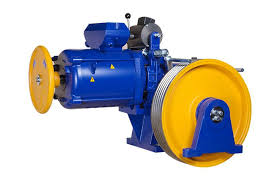Elevator Engine

The motors used in elevators enable the system to move. The elevator motor produces the power required to move the elevator cabin up and down. Elevator motors, which we encounter as electric motors, are either geared or gearless types. While geared elevator motors are generally preferred for heavier loads, gearless elevator motors are quieter and require less maintenance. The elevator engine, which facilitates vertical transportation in modern buildings, is of great importance in terms of efficiency and safety. In short, the elevator engine offers a safe and comfortable elevator experience.
How Does an Elevator Engine Work?
1. Receiving Electrical Energy:
• The elevator engine receives electrical energy from the network and operates using this energy.
2. Engine Operation:
• Electrical energy creates a rotating movement through the electromagnets inside the motor. This movement produces mechanical energy by rotating the shaft of the motor.
3. Gearless or Gear System:
3.1. Gearless Elevator Motor:
• The motor shaft is directly connected to the pulley.
• Since this design contains fewer moving parts, it operates more quietly and requires less maintenance.
3.2. Gear Elevator Motor:
• The rotational movement produced by the engine is transmitted to the pulley through a gear box.
• The gear box increases the torque of the engine by decreasing its speed. Thus, it allows carrying heavier loads.
4. Pulleys and Ropes:
• The motor moves the ropes by rotating the pulley.
• Ropes; They are steel cables, one end of which is connected to the elevator cabin and the other end to the counterweight.
5. Counterweight:
• The counterweight balances the weight of the elevator car and allows the engine to consume much less energy.
• When the cabin goes up, the counterweight goes down, and vice versa, it goes up.
6. Speed Control and Braking:
• The elevator engine is equipped with a speed control unit.
• This unit controls the direction and speed of the motor and enables the elevator to start and stop softly.
• The brake system is activated in emergency situations by ensuring that the cabin remains stationary when the engine is not running.
7. Control Panel and Sensors:
• The elevator motor is monitored and controlled by the elevator’s control panel and various sensors.
• These sensors constantly monitor the speed and position of the cabin and make the necessary adjustments.
8. Security Systems:
• Elevator engine; It is protected by security systems in cases such as overload, overspeed or power outage.
• These systems stop the engine or perform emergency braking to ensure the safety of users.
Where is Elevator Engine Used?
Elevator engines are used to provide vertical transportation in various facilities and buildings. Some areas of use are as follows:
1. Residential Buildings: It provides transportation between floors in sites, apartments and detached houses.
2. Industrial Facilities: It is used to transport materials and products in warehouses, factories or production facilities.
3. Commercial Buildings: It is used to carry heavy human traffic in shopping malls, office buildings, hotels or business centers.
4. Airports and Train Stations: It is used to transport passengers and luggage in a fast and safe manner.
5. Hospitals: Specially designed elevator motors are widely used for patient transport elevators, medical equipment or stretchers.
6. Hotels and Restaurants: Kitchen elevators are used as passenger elevators or passenger elevators.



